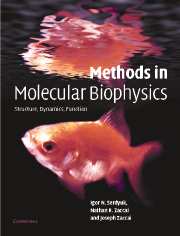Book contents
- Frontmatter
- Contents
- Foreword by D. M. Engelman
- Foreword by Pierre Joliot
- Preface
- Introduction: Molecular biophysics at the beginning of the twenty-first century: from ensemble measurements to single-molecule detection
- Part A Biological macromolecules and physical tools
- Part B Mass spectrometry
- Part C Thermodynamics
- Part D Hydrodynamics
- Part E Optical spectroscopy
- Part F Optical microscopy
- Part G X-ray and neutron diffraction
- Chapter G1 The macromolecule as a radiation scattering particle
- Chapter G2 Small-angle scattering
- Chapter G3 X-ray and neutron macromolecular crystallography
- Part H Electron diffraction
- Part I Molecular dynamics
- Part J Nuclear magnetic resonance
- References
- Index of eminent scientists
- Subject Index
- References
Chapter G2 - Small-angle scattering
from Part G - X-ray and neutron diffraction
Published online by Cambridge University Press: 05 November 2012
- Frontmatter
- Contents
- Foreword by D. M. Engelman
- Foreword by Pierre Joliot
- Preface
- Introduction: Molecular biophysics at the beginning of the twenty-first century: from ensemble measurements to single-molecule detection
- Part A Biological macromolecules and physical tools
- Part B Mass spectrometry
- Part C Thermodynamics
- Part D Hydrodynamics
- Part E Optical spectroscopy
- Part F Optical microscopy
- Part G X-ray and neutron diffraction
- Chapter G1 The macromolecule as a radiation scattering particle
- Chapter G2 Small-angle scattering
- Chapter G3 X-ray and neutron macromolecular crystallography
- Part H Electron diffraction
- Part I Molecular dynamics
- Part J Nuclear magnetic resonance
- References
- Index of eminent scientists
- Subject Index
- References
Summary
Theory of small-angle scattering from particles in solution
Small-angle scattering (SAS) is a very useful method in biochemistry, providing information on molecular masses, shapes and interactions in solution (see Comment G2.1).
Dilute solutions of identical particles
In order to have an observable signal in X-ray or neutron SAS a solution of the order of 100 μl containing a few milligrams per millilitre of macromolecule is required – corresponding to about 1015 particles for a 50 kDa protein at 1 mg ml−1 (we note that 1 mg ml−1, the usual unit in biochemistry is in fact equal to 1 g l−1, the unit more conveniently used in equations).
We first consider solution conditions such that the particles do not influence each other, i.e. the position and orientation of each particle is totally independent of that of the others. This is the infinite dilution condition, for which we say there is no interparticle interference. In practice, it is achieved at different, low, concentrations for different macromolecules and solvents. For example, the condition may well be satisfied for a given protein at a few milligrams per millilitre, in a neutral pH buffer, but tRNA molecules, which are highly charged at pH 7 in low-salt buffer, interact with each other even at these concentrations, and it might not be possible to reach the infinite dilution condition without increasing the solvent salt concentration.
- Type
- Chapter
- Information
- Methods in Molecular BiophysicsStructure, Dynamics, Function, pp. 794 - 837Publisher: Cambridge University PressPrint publication year: 2007
References
- 1
- Cited by



